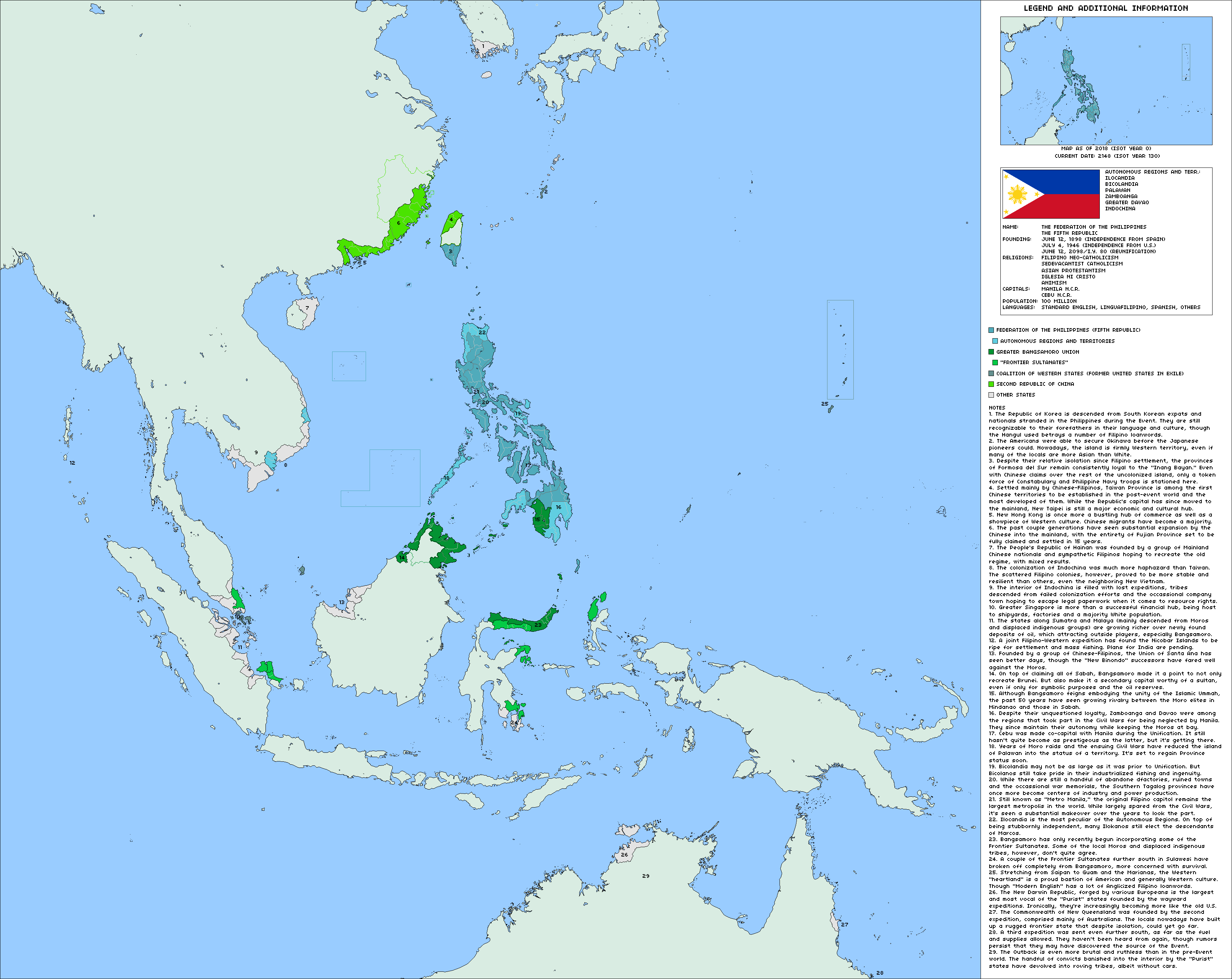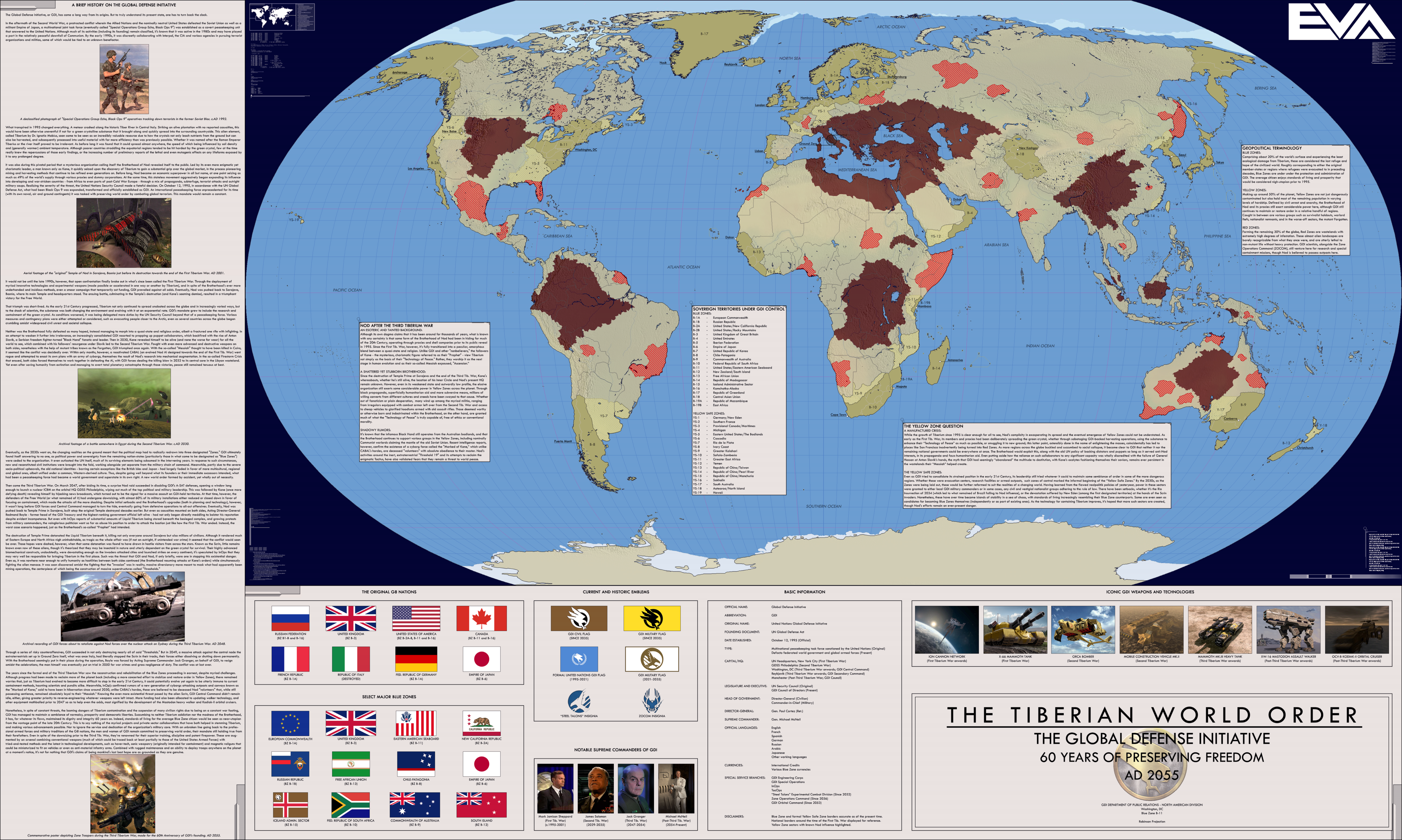HOME | DD
 mdc01957 — Pearl in the Sea of Time: A Philippines ISOT Map
mdc01957 — Pearl in the Sea of Time: A Philippines ISOT Map

#ah #alternate #au #map #pearl #philippines #sea #time #isot #alternatehistory #alternateuniverse #filipino #history #profile #alternatehistorymap
Published: 2018-06-03 16:51:58 +0000 UTC; Views: 14389; Favourites: 81; Downloads: 101
Redirect to original
Description
After getting some stuff done, here's something a little different: an ISOT map featuring my homeland, the Philippines.
For those unfamiliar, ISOT is short for Island in the Sea of Time, a Sci-Fi/Alternate History series by S.M. Stirling. The term itself refers to taking regions if not whole countries to another time period, universe, etc. for whatever reason. In this case, it's the Philippines (along with the Marianas and Guam) transplaned onto an empty "Virgin Earth" and seeing what would happen after over a hundred years.
As a bit of trivia, the version of the Philippine flag used in the map is an unused proposal wherein there are nine sun rays, whose meaning tends to vary depending on one's politics.
Hopefully it's clear that this isn't meant to be a political or ideological screed of any kind. This is a work of fiction. That being said, I hope you enjoy!
----
It's the year A.D. 2148. 130 years have passed since a mysterious phenomenon known only as the Event transported the Republic of the Philippines, along with the entirety of the Marianas to another, empty version of Earth. No one is left alive who remembers first-hand what life was like before everything changed forever, just as no one is left who really cares to figure out what actually caused the Event. Yet this much is certain: The more things change, the more they stay the same.
Today, the Federation of the Philippines, also known as the Fifth Republic, remains the largest nation in the civilized world and among the most prominent, though not without a few costly hurdles. The "Third Republic" had endured President Rodrigo Duterte's draconian if necessary "Emergency Measures" following the Event and the first couple generations. The Filipino people even used ingenuity and what resources they've been able to stockpile to explore (and expand into) their new surroundings, most notably Taiwan/Formosa del Sur. Still, the reforms instituted in the name of stability and survival did little to contain years' of pent-up tensions spanning across class, regional and political lines; neither did the constant threats posed by the Moros. Eventually, it brought about a period known as the Filipino Civil Wars, a vestigial "Fourth Republic" (based from Manila and Cebu) made up of loyalist provinces and regions holding the line. Since the Unification of 2098, however, the country has seen a resurgence that would have been nigh unthinkable decades before. Some chalk it up to the implementation of an American-inspired federal system and the decision to grant regions like Ilocandia or Davao significant autonomy rather than punishing them. Others point to can-do patriotism, the return of religiousity (led by various Catholic successors) and the rekindling of old-fashioned Bayanihan despite the hardships of those tumultuous times.
Across the Philippine Sea is the Coalition of Western States. Originally the United States-in-Exile, the Marianas soon became home to several Americans and Europeans (such as tourists, expats, delegates and military personnel) left stranded during the Event, with more coming amidst the Civil Wars. While order was maintained and the remnants of the U.S. Military were able to secure a number of outlying islands such as Okinawa, the fact that no one from Washington's answering their calls and the reality of their new world meant that eventually, new communities were formed by the various groups and refugees. In time, the authorities in Guam finally conceded, electing instead to follow a different path. Since then, however, Western entrepreneurs, engineers, explorers and artists have made their presence felt across the civilized world. Areas like Hong Kong and Singapore have even been "recreated" in their image over the years, but not just as crucial economic/financial hubs or even as crucial naval bases. Rather, such projects and initiatives are meant to reassert the superiority of secular Western civilization, all the while preserving as much of it as they could. For the most part, it's been a resounding success, though the "Modern English" used has more than a few Anglicized loans of Filipino origin or that the definition of "Whites" now includes mixed-race/mestizos with any significant Anglo-American/European background.
The Moros, meanwhile, have forged their own destiny as the self-proclaimed embodiment of the Islamic Ummah. Based largely from the Muslim-majority portion of the island of Mindanao, they were quick to exploit the ensuing turmoil of the Event. Beginning with calls for ever-greater autonomy, what became the Greater Bangsamoro Union grew increasingly aggressive with defying weakening Filipino authority that it's effectively independent. The Civil Wars gave the resurgent datus and sultans even more ample room, allowing would-be warlords to make a name for themselves either battling the divided infidels or "reclaiming" lands like Sabah and Brunei. This is saying nothing of the myriad "Frontier Sultanates" founded by Moros hoping to spread Allah's message or simply build new lives for themselves. Of course, things have changed from the days of rampant raids and impromptu jihads. Even the supposed unity of the Ummah is challenged, most infamously by rivalries among the Moros of Mindanao and Sabah. Yet with growing attention to securing oil and building actual infrastructure, Bangsamoro has remained both a major player and a thorn to their Filipino neighbors.
Then there's the Second Republic of China. Following the Event, a group comprised mainly of Taiwanese, Mainland Chinese and Chinese-Filipinos (particularly those of Fukien/Hookien origins) agreed to undertake an organized "reclamation" of the Middle Kingdom, without something like Beijing or the People's Liberation Army getting in the way. Over the following decades, the pioneers, their descendants and subsequent Chinese-Filipino migrants established themselves in northern Taiwan and parts of the Mainland, mainly where Guangdong and Fujian Provinces would have been. To be sure, there were hardships to be had in trying to build over virgin soil, let alone facing the unknown beyond the safety of their homesteads. Yet despite the cynicism expressed by some, the Chinese have been able to not simply survive but also emerge as a rising nation, be it through agricultural exports or a rebirth in industry and culture. Their growing population is also beginning to match Filipino rates, with some expecting that they may once more be the world's most populous group within the next century. Something undoubtedly that may be contributing to the increasing rate that they're settling the fringes of the civilized world.
This isn't to discount the other political developments that had emerged since the Event. Various others nationalities found themselves stranded in the Philippines (mainly Asian), which tried to embark on their own colonization efforts. Some like the Korean efforts to resettle their homeland proved to be more successful than others, such as the various frontier states across Indochina. Meanwhile, various companies and lobbyist groups (whether from the Philippines or the Western territories) have tried to build their own colonies and settlements with mixed success, to say nothing of the various "displaced' indigenous tribes trying to make their own path. The most peculiar, arguably would be the legacy of the "Purist" expeditions. Believing that the authorities in Guam had "gone native" and fearing for the loss of their heritage, three Western groups set off to rebuild society in their "pure" image. While the last of these voyages is presumed to have ended in disaster, the ensuing "Purist" states have much to back their claims of being enclaves of proper, Christian European or Anglo-Australian culture, at least when they're not struggling against the rigors which come with living in the Outback.
While there were fears that civilization would collapse into primal anarchy, technology-wise the prominent nations of the new world enjoy standards generally on par with the mid 20th Century A.D., though with some touches. Travel is mostly by sea or with rail for instance, though aircraft is once more coming into vogue. Certain side-effects of the overarching needs of survival and order, however, hasn't just been the strong emphasis on ingenuity, often making do with dwindling supplies. But in the process, it's also driven home the need of education and preservation in a way that would have been difficult before the Event due to complacency. Among other things, this has led to Filipino and Western scholars making breakthroughs in potentially recreating the Internet, thanks to having several hard copies of online data. On the flip-side however, this is also sparking renewed tensions surrounding "virgin" oil reserves and other resources ripe for the taking.
There are other rumors spreading through the wires, however. Rumors of strange, English transmissions coming from Hawaii and possibly North America, suggesting that they may not be as alone in this new world as they like to believe. Which in turn seem related to hearsay that the lost "Purist" expedition may have discovered the source of whatever brought about the Event, though few really care to even know.
In the streets of Manila and Cebu though, that matters little. What does is that, by God's grace all's right with the world.
Related content
Comments: 26

👍: 0 ⏩: 0

👍: 0 ⏩: 1

👍: 0 ⏩: 0

👍: 0 ⏩: 1

I'd like to hear what their version of English with Filipino loanwords sounds like ^^
👍: 0 ⏩: 0

hi i'm fom the Philippines as well what happened to my hometown Binan City, Laguna after the event?
👍: 0 ⏩: 1

how is Filipino society doing in 2148? can you explain?
👍: 0 ⏩: 0

Were there not enough stranded Japanese tourists to form communities, or are they just unable/unwilling to try to resettle the Home Islands?
👍: 0 ⏩: 1

There weren't quite enough. Though they did largely succeed in resettling most of the Ryukyu Islands.
👍: 0 ⏩: 0

Finally, have been waiting for something like this for the Philippines.
Now I am planning to make my own Philippine ISOT.
👍: 0 ⏩: 1

mrtrollface2022 , do you think it's when the Philippines is in after World War III (in When the Cold Breeze Blows Away)?
👍: 0 ⏩: 1

No.
It's more of a "transplant the country to an empty world"
👍: 0 ⏩: 1

Awww man. Sorry 'bout that!
👍: 0 ⏩: 0

MABUHAY KA PILIPINAS!!!!!
MABUHAY! MABUHAY!! MABUHAY!!!
[The crowd cheers in joy and happiness.]
👍: 1 ⏩: 0

Thanks!
It took a bit of time to sort out the smaller details.
👍: 0 ⏩: 0

I love ISOT's. I've got one of my own in the works.
👍: 0 ⏩: 1

Nice! Hope you like this one!
👍: 0 ⏩: 0

Nice map so far. I guess the politicians are still in their old ways, right?
I wonder what Duterte is doing after the event.
👍: 0 ⏩: 1

The Event doesn't exactly do wonders with social stability...
👍: 0 ⏩: 0




























